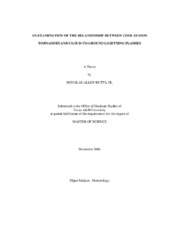| dc.description.abstract | The southeast United States is prone to severe weather throughout the year.
Despite technological advances, some severe weather events occasionally remain
unwarned in this part of the country. Past studies examined the relationship between
cloud-to-ground (CG) lightning and warm season severe weather episodes. The present
study examined the relationship between cool season tornadoes and CG lightning, with a
focus over the southeastern United States, where most cool season tornadoes occur.
Data from the Storm Prediction Center and National Lightning Detection Network
(NLDN) were used to investigate CG lightning properties within 50 km and one hour
before tornado touchdown. This was completed over a period of 13 cool seasons from
October 1989 through March 2002.
Of 3325 tornado events, 2358 contained at least one NLDN-detectable flash. CG
lightning attributes of peak current, multiplicity, and flash density compared well with
those of prior warm season lightning research. Overall event frequency appeared to be
lower than in the warm season. Almost all Central Plains events were accompanied by
at least one NLDN-detectable flash. Up to 70% of tornado events near the Gulf of
Mexico and Atlantic coasts contained no NLDN-detectable lightning. Although it is not known why this trend was observed, it is speculated that NLDN detection efficiency
and/or storm structure differences may play a role in these observations.
Warm season studies have correlated tornadoes with predominantly positive
(>50% positive CG lightning), or PPCG storms. Gridded maps showed the greatest
percentage and highest frequency of cool season PPCG storms across Kansas and
Nebraska, with up to 70% of events associated with PPCG lightning. A secondary,
albeit lower, frequency maximum extended 1° to 2° inland across Louisiana into North
Carolina. This study also subjectively defined a storm with “enhanced†positive cloud-to-ground (EPCG) lightning as one containing >25% positive cloud-to-ground lightning,
which corresponds to approximately the 75th percentile of all cool season tornadoes.
This has lead to speculation that EPCG criterion may be a better indicator of the
possibility of severe weather than the traditional PPCG criterion. | en |


